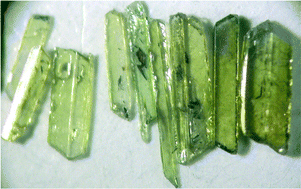Crystallization of HPHT diamond crystals in a floatage system under the influence of nitrogen and hydrogen simultaneously
Abstract
Employing floatage as a driving force for diamond growth, the crystallization of diamond crystals in a Fe–Cr–C system co-doped with nitrogen and hydrogen elements is established at a static pressure of ~6.5 GPa and a temperature range of 1335–1485 °C. Under the influence of nitrogen and hydrogen incorporated into the diamond structure simultaneously, a rich morphological diversity of diamond specimens is produced, such as hexagonal slice-shape, trapezoidal slice-shape, strip shape and triangular slice-shape crystals. Observation of the infrared spectra of the as-grown crystals indicates that a dramatic enhancement in the simultaneous incorporation of hydrogen and nitrogen atoms into the diamond structures is present in the strip-shape specimens, confirmed by the fact that relatively high absorption coefficients of the peaks at 1130 cm−1, and 1344 cm−1 are accompanied with high absorption coefficients of the bands at 2850 cm−1 and 2920 cm−1. Hydrogen-related absorption in the three-phonon region further indicates that hydrogen atoms exist in the diamond structures as sp3 bonded –CH2– and –CH3 group forms. At atmospheric pressure, these hydrogen-containing structures are rather stable and can sustain high temperatures of up to 1800 °C. Nitrogen donors are universally observed as an isolated substitutional form in the crystals, while minor paired-form nitrogen atoms are readily formed in the strip shape crystals or other crystals crystallized at higher temperature.


 Please wait while we load your content...
Please wait while we load your content...